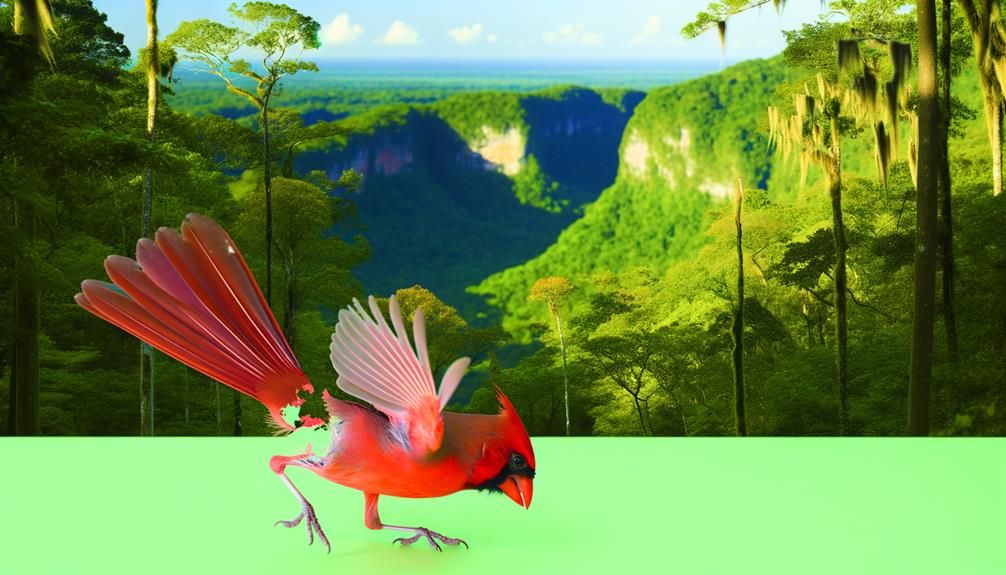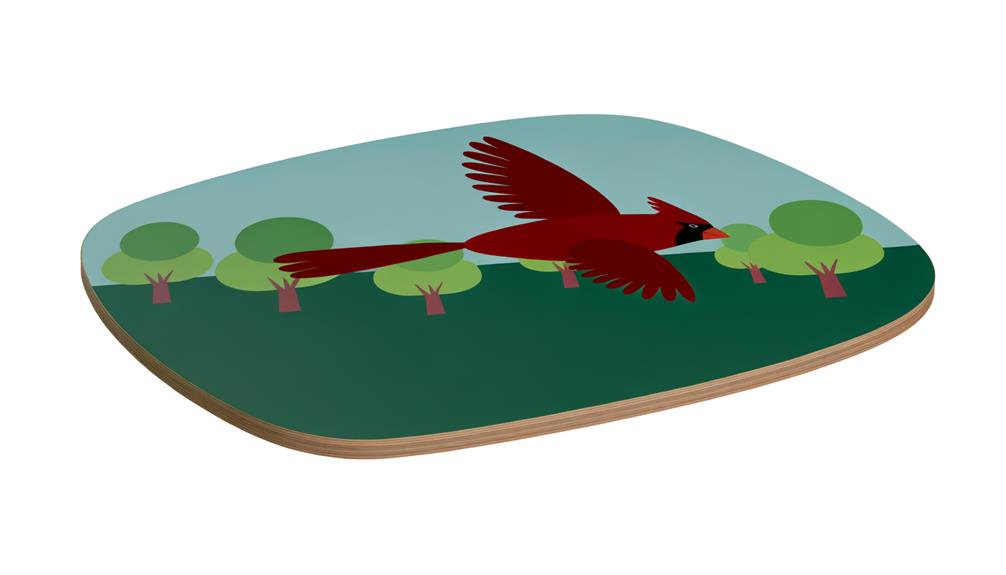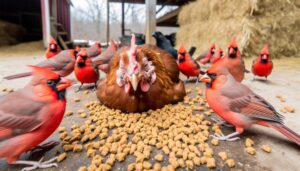Helping Cardinals Fly Without Tail Feathers: A Practical Guide
Yes, a cardinal can fly without tail feathers, but it's far less efficient. Without these rectrices, you'll notice impaired maneuverability and disrupted aerodynamic control.
The tail feathers act as a rudder, essential for stability and precise turns. Without them, cardinals overwork their wings, resulting in increased energy expenditure and less effective foraging.
Observations in nature show unstable flights, abrupt altitude changes, and uncontrolled spirals. They adapt by leveraging rapid wingbeats and strong pectoral muscles, yet their vulnerability to predators and hazards increases.
Learn how cardinals adjust their behaviors further to maintain flight.

Key Takeaways
- Cardinals can fly without tail feathers, but their flight becomes unstable and less precise.
- Maneuverability and braking efficiency are significantly impaired without tail feathers.
- Tail loss increases energy expenditure due to overworked wings compensating for lost control.
- Cardinals adapt by using rapid wingbeats and frequent short hops for stability.
- Absence of tail feathers heightens the risk of predation and environmental hazards.
Importance of Tail Feathers

Tail feathers, or rectrices, play an essential role in a cardinal's flight dynamics by providing stability and aiding in maneuverability. You'll notice that these feathers act as rudders, helping the bird maintain steady flight and execute sharp turns.
The rectrices' structure, with strong central shafts and vane symmetry, distributes aerodynamic forces evenly. Without these, a cardinal's ability to control pitch and yaw would be compromised, making agile movements difficult. The rectrices also contribute to braking during landing, absorbing kinetic energy to prevent injury.
Observing a cardinal in flight reveals the seamless coordination between wing and tail feathers, underscoring their importance. The absence of tail feathers would disrupt this synergy, critically affecting the bird's navigational precision and overall flight efficiency.
Cardinal Flight Mechanics
Understanding fundamental flight mechanics involves analyzing how different feather groups, especially the wings and tail, collaborate to achieve efficient and controlled movement.
You'll notice that their primary flight feathers produce lift and thrust through rapid wingbeats. These feathers are aerodynamically shaped to minimize resistance.
The secondary feathers, closer to the body, stabilize flight, ensuring smooth gliding.
The tail feathers, or rectrices, act as a rudder, providing stability and aiding in maneuverability. By fanning or folding the tail, cardinals can execute tight turns and abrupt stops.
The interplay between wing and tail movements is essential for maintaining altitude and overcoming obstacles. Mastering these mechanics allows cardinals the freedom to explore their environment with agility and precision.
Effects of Tail Loss

Losing tail feathers noticeably impairs a cardinal's ability to maneuver, stabilize during flight, and execute precise turns. Without these critical appendages, you'll observe a marked reduction in aerodynamic control.
Tail feathers act as a rudder, facilitating sharp directional changes and maintaining equilibrium. Their absence disrupts the bird's center of gravity, increasing susceptibility to turbulence and erratic flight patterns.
Moreover, the lack of tail feathers affects the bird's ability to brake efficiently, leading to awkward landings. You'd notice that a cardinal compensates by overworking its wings, resulting in increased energy expenditure and potential fatigue.
This inefficiency can limit the bird's ability to escape predators or forage effectively, impacting its overall survival and freedom in the wild.
Observations in Nature
In the wild, you'll observe cardinals with missing tail feathers struggling to maintain stable flight and exhibiting noticeably erratic movements. These birds experience compromised aerodynamic control, which directly impacts their ability to navigate through dense foliage or evade predators.
You'll notice increased frequency of abrupt altitude changes and uncontrolled spirals. Their landing approaches become more abrupt and less precise, often resulting in clumsy touchdowns. Additionally, their overall flight speed decreases, and energy expenditure increases as they attempt to compensate for the lack of tail-induced stability.
You might also see heightened vulnerability to environmental hazards, as their impaired maneuverability makes them easy targets. Such observations underscore the critical role tail feathers play in avian flight dynamics and survival.
Adaptations and Recovery

Frequently, cardinals exhibit remarkable adaptive behaviors to cope with the loss of tail feathers, leveraging their wing strength and agility to regain stability and control during flight.
You'll notice these birds employ rapid wingbeats to create additional lift, compensating for the reduced aerodynamic control usually provided by tail feathers.
Cardinals also adjust their flight paths, opting for shorter, more frequent hops between perches to minimize the need for extended gliding.
Additionally, they use their strong pectoral muscles to enhance maneuverability, making quick directional changes easier.
Through these adaptations, cardinals demonstrate resilience, ensuring they can still forage, evade predators, and navigate their environment effectively.
This ability to recover showcases the cardinal's innate drive for survival and autonomy.
Conclusion
Without its tail feathers, a cardinal's flight becomes a struggle against gravity's relentless pull. You'd witness a once-graceful bird reduced to erratic, laborious flutters, its aerial ballet disrupted.
This vivid proof of nature's intricate design highlights how critical tail feathers are for stability and maneuverability. Yet, don't underestimate the resilience of these avian wonders; with time, their adaptive mechanisms kick in, and many recover, regrowing their plumage and rediscovering the skies.






